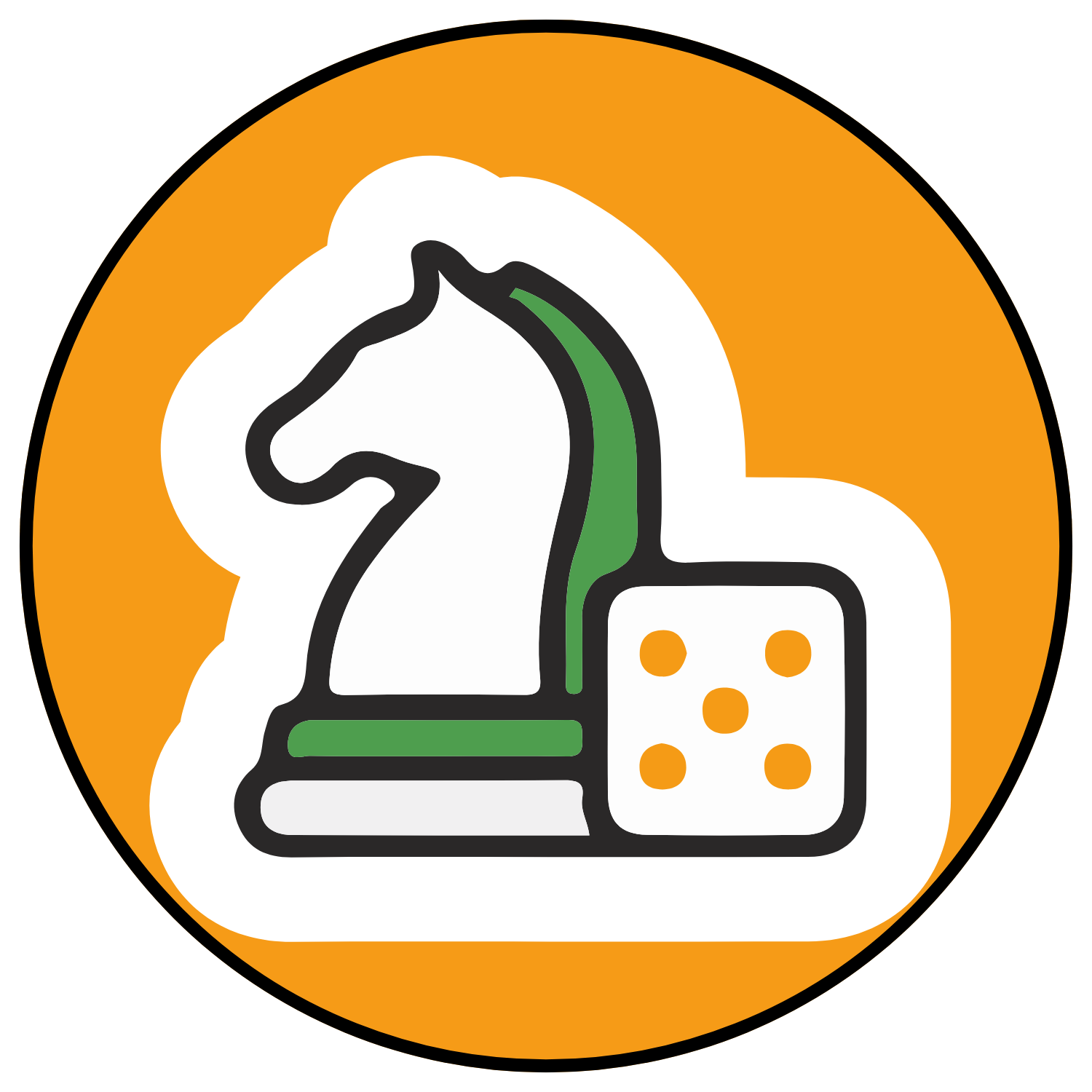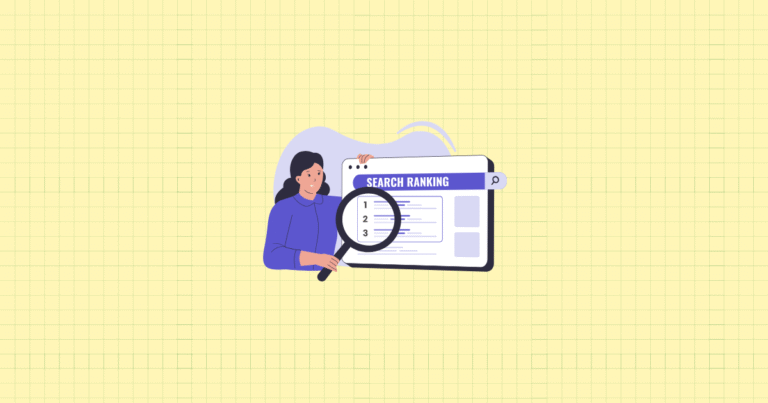Ever notice how some Shopify stores seem to effortlessly attract visitors, convert customers, and build passionate followings while others struggle to gain traction? The difference often comes down to one thing: a strategic approach to content. In today’s crowded e-commerce landscape, products alone won’t distinguish your Shopify store. Content has become the secret weapon that turns casual browsers into loyal buyers.
But here’s the challenge: creating content without strategy is like sailing without a compass. You might move, but are you heading in the right direction? Many store owners pour hours into blogs, product descriptions, and social posts without seeing meaningful results. They’re working harder, not smarter.
That’s where a tailored Shopify content strategy changes everything. When your content is purposeful, targeted, and integrated with your store’s ecosystem, it transforms from a time-consuming obligation into your most powerful sales driver. In this guide, you’ll discover exactly how to develop and implement a content strategy specifically optimized for Shopify’s unique environment.
We’ll explore how to leverage Shopify’s native features, create content that resonates with your specific audience, and measure what actually impacts your bottom line. By the end, you’ll have a clear roadmap for turning content into your competitive advantage – regardless of your store’s size or niche.
Understanding Content Strategy in the Shopify Context
Content strategy in e-commerce isn’t just about creating blog posts or product descriptions. It’s a comprehensive approach that aligns every piece of content with your business goals. For Shopify merchants, this means crafting and distributing valuable content that guides potential customers through their buying journey while leveraging the platform’s unique capabilities.
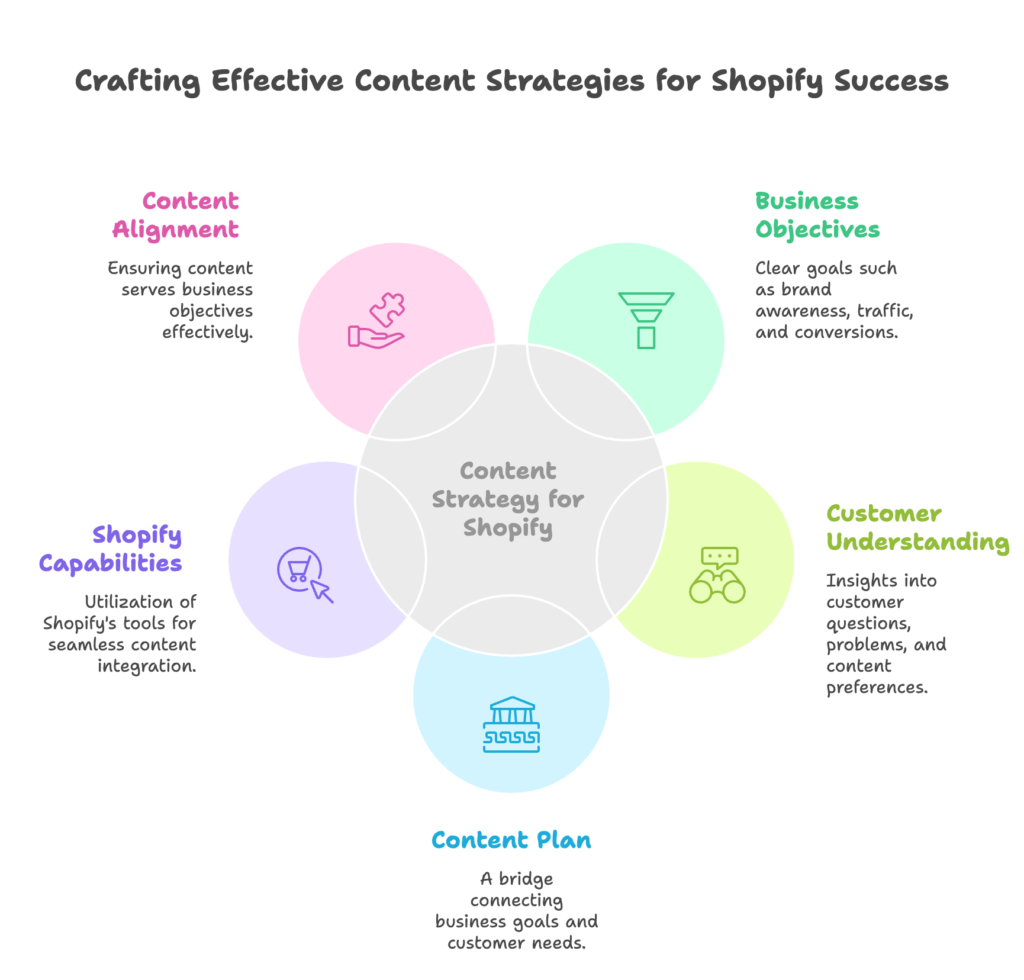
Defining Content Strategy for E-commerce
At its core, an effective e-commerce content strategy consists of several key components that work together. First, you need clear business objectives – are you primarily focused on building brand awareness, increasing organic traffic, or boosting conversion rates? Second, you need deep customer understanding – what questions do they have, what problems are they trying to solve, and what content formats do they prefer? Third, you need a content plan that bridges the gap between these two elements.
For Shopify stores specifically, your content strategy must adapt to the platform’s structure and capabilities. This means thinking about how content will flow through your store’s architecture, from collection pages to product descriptions to blog posts. It also means understanding how Shopify’s SEO works differently than other platforms.
A common mistake? Approaching content as an afterthought rather than an integral part of your store’s foundation. Your products and content should work in harmony, each enhancing the other’s effectiveness.
Shopify’s Native Content Capabilities
Shopify offers several built-in features for content creation and management that form the building blocks of your strategy. The platform’s blog functionality provides a straightforward way to publish articles, guides, and updates. While not as robust as dedicated blogging platforms, it integrates seamlessly with your store and contributes to your domain authority.
Product descriptions and collections represent another crucial content area. These aren’t just technical specifications – they’re persuasive selling tools that address customer concerns and highlight benefits. Shopify’s customizable templates give you flexibility in how this information is presented.
Beyond these basics, Shopify’s page builder allows you to create custom pages and sections without coding knowledge. This is where you can develop cornerstone content like detailed buying guides, about pages that tell your brand story, and landing pages for specific campaigns or product launches.
“The power of Shopify’s content system lies in its integration,” explains Mark Richardson, an e-commerce consultant who’s built over 50 Shopify stores. “When your blog content, product information, and custom pages all live within the same ecosystem, you create a seamless experience that guides customers naturally toward purchase.”
Aligning Content Strategy with Shopify Store Goals
Different stores have different priorities, and your content strategy should reflect that. If increasing organic traffic is your primary goal, you’ll want to focus heavily on SEO-optimized blog content and product descriptions that target relevant keywords. This means researching terms your customers actually use and creating content that genuinely answers their questions.
For stores focused on improving conversion rates, your content needs to address objections and build trust at key decision points. This might mean developing detailed FAQ sections, creating comparison guides between your products, or showcasing user-generated content that provides social proof.
Customer retention presents yet another content opportunity. Email newsletters featuring useful tips, exclusive content for existing customers, and personalized product recommendations can significantly increase customer lifetime value. Shopify’s email marketing tools make this easier to implement than you might think.
The key is alignment. Every piece of content should serve at least one of your primary business objectives. If it doesn’t, it’s probably not worth creating.
Developing a Shopify-Optimized Content Strategy
Having understood the importance of content strategy for your Shopify store, let’s roll up our sleeves and get practical. Developing an effective strategy isn’t about following generic best practices – it’s about creating a tailored approach based on your unique store, products, and customers.
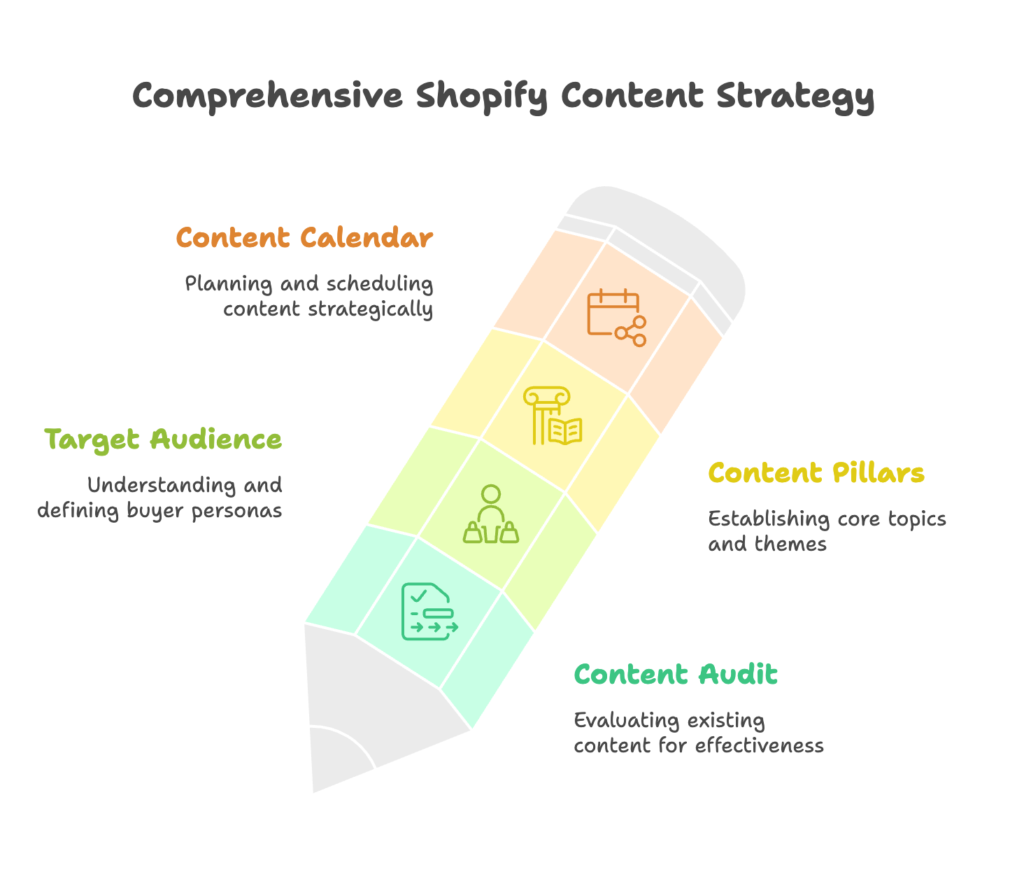
Conducting a Shopify Store Content Audit
Before creating new content, take stock of what you already have. A thorough content audit reveals what’s working, what’s not, and where opportunities lie. Start by cataloging all existing content – product descriptions, blog posts, collection pages, about pages, FAQ sections, and even transactional emails.
For each content piece, note key metrics: traffic, time on page, bounce rate, and most importantly, conversion impact. Shopify’s analytics make this relatively straightforward, especially when connected with Google Analytics. Look for patterns. Which product descriptions lead to the most adds-to-cart? Which blog posts drive the most sales?
Next, identify gaps in your content. Are there common customer questions that remain unanswered? Customer service inquiries often reveal these gaps. Are there high-volume keywords in your niche that you’re not targeting? Are certain stages of the buyer’s journey lacking supportive content?
Finally, analyze what your competitors are doing. Which content types are they prioritizing? What topics are they covering? Look beyond direct competitors to industry leaders who excel at content marketing. Their strategies can provide valuable inspiration, though you’ll want to adapt rather than copy their approach.
Defining Target Audience and Buyer Personas
Generic content rarely converts. To create content that resonates, you need to know exactly who you’re talking to. Shopify provides powerful tools for understanding your audience, starting with your store analytics. Pay attention to demographics, but don’t stop there.
Dive deeper by examining purchasing patterns. Which products do first-time buyers typically purchase? Which products appeal to returning customers? How does buying behavior differ across customer segments? These insights help you develop more nuanced content targeting.
With this data, create detailed buyer personas that go beyond basic demographics. What motivates each persona? What objections might they have? What questions do they need answered before making a purchase? What content formats do they prefer?
“Most Shopify stores make the mistake of creating one-size-fits-all content,” notes Sarah Chen, founder of E-commerce Content Lab. “But a first-time visitor needs different information than someone who’s purchased three times before. Your content strategy should account for these differences.”
Remember that personas evolve as your business grows and markets change. Revisit and refine them quarterly based on new data and customer feedback.
Establishing Content Pillars and Themes
Content pillars are the core topics around which you’ll build your content strategy. For Shopify stores, these pillars often align with product categories, customer interests, or brand values. For example, a sustainable clothing store might have pillars around ethical manufacturing, fabric sustainability, and timeless style.
For each pillar, develop a list of subtopics and potential content pieces. This creates a structured approach that ensures comprehensive coverage while preventing random, disconnected content creation. It also helps establish topical authority in your niche, which benefits both SEO and brand positioning.
Balance is crucial when planning your content mix. Educational content builds trust and attracts new visitors through search. Promotional content drives conversions. Inspirational content creates emotional connections with your brand. Most Shopify stores need all three types, though the ratio will depend on your specific goals.
As you establish your content pillars, think about how they’ll manifest across different parts of your Shopify store. A pillar topic might appear as a collection page, a series of blog posts, and elements within product descriptions – creating a cohesive narrative throughout the customer journey.
Creating a Content Calendar Tailored to Shopify
Consistency matters in content marketing. A content calendar helps you plan ahead, allocate resources efficiently, and maintain a steady publishing schedule. For Shopify stores, this calendar should align with your sales cycles and promotional events.
Start by mapping out key dates for your business – major sales events like Black Friday, seasonal peaks, product launches, and industry events. These represent opportunities for targeted content that supports your marketing initiatives. Plan larger content pieces around these dates, with lead time to build anticipation.
Between these tentpole events, schedule regular content that addresses evergreen topics within your pillars. This creates a foundation of valuable information that continues to attract and convert customers regardless of season.
Consider content dependencies and workflows when building your calendar. A product launch might require a sequence of content: teaser social posts, an announcement email, a detailed blog post, and updated collection pages. Planning these elements together ensures consistency and maximum impact.
Tools like Trello, Asana, or even a simple spreadsheet can help manage your content calendar. The key is having visibility across all content types – not just blog posts, but product updates, email newsletters, and social media campaigns as well.
Content Creation and Optimization for Shopify
With your strategy in place, it’s time to create content that converts. Shopify’s unique environment offers specific opportunities for optimization that can dramatically impact your store’s performance. Let’s explore the key content areas where you should focus your efforts.
Crafting Compelling Product Descriptions
Product descriptions often make or break sales. Yet many Shopify store owners treat them as an afterthought, resulting in generic, feature-focused text that fails to engage customers. Exceptional product descriptions blend practical information with persuasive storytelling.
Start with SEO fundamentals. Research the terms customers actually use to find products like yours. Incorporate these naturally into your titles, descriptions, and metadata. But don’t write for search engines at the expense of human readers – Google rewards engaging, helpful content that answers searcher intent.
Focus on benefits over features. Instead of just listing specifications, explain how the product improves the customer’s life. A feature might be “100% merino wool,” but the benefit is “stays warm even when wet and prevents overheating during activity.” Connect features directly to customer problems and desires.
Shopify’s product description template offers flexibility, but requires thoughtful structure. Use short paragraphs, bullet points for scannable information, and subheadings to break up longer descriptions. Consider creating a consistent format across similar products to improve the shopping experience.
Don’t forget about visual elements. High-quality images showing the product from multiple angles, in-context usage photos, and even embedded videos can significantly boost conversion rates. Shopify’s product page builder makes it easy to incorporate these rich media elements.
Developing a High-Impact Blog Strategy
Your Shopify blog isn’t just a publishing platform – it’s a powerful tool for attracting traffic, establishing authority, and nurturing potential customers. Each post should serve a specific purpose in your broader strategy.
When selecting blog topics, prioritize those with commercial intent or educational value related to your products. Tools like Ahrefs, SEMrush, or even Google’s Keyword Planner can help identify topics with search potential. But don’t just chase volume – relevance to your audience and products is more important than raw search numbers.
Structure your blog posts for both readability and SEO. Use descriptive H2 and H3 subheadings that incorporate related keywords. Break up text with images, quotes, or callout boxes. Include internal links to relevant products and other content pieces, creating pathways for readers to explore your store further.
“The most successful Shopify blogs answer real questions customers have during their buying process,” explains Jordan Michaels, content director at E-commerce Evolved. “They’re not publishing random articles – they’re creating resources that directly support purchase decisions.”
Rich media enhances engagement and shares. Consider incorporating custom graphics, product demonstration videos, or even interactive elements like quizzes or calculators when relevant. These elements increase time on page and social sharing, both of which can positively impact your search rankings.
Leveraging Shopify’s Custom Pages for Cornerstone Content
Beyond product pages and blog posts, Shopify’s custom pages allow you to create in-depth resources that serve as foundations for your content strategy. These cornerstone content pieces typically address broader topics and link to more specific content.
Buying guides represent one of the most valuable custom page types. These comprehensive resources help customers navigate complex purchase decisions, comparing options and highlighting important considerations. For example, a kitchenware store might create a “Complete Guide to Choosing Kitchen Knives” that educates customers while naturally showcasing their product selection.
Brand story pages create emotional connections that generic stores can’t match. Use Shopify’s page builder to craft compelling narratives about your founding, values, and mission. Include visuals that bring your story to life – founder photos, behind-the-scenes glimpses, or timeline graphics showing your evolution.
Campaign landing pages deserve special attention for time-sensitive promotions. These focused pages should have clear messaging, strong visuals, and simplified navigation that guides visitors toward specific actions. By creating dedicated URLs for these pages, you can track campaign performance more accurately and optimize based on results.
When designing custom pages, maintain visual consistency with the rest of your store while adapting layouts to suit the content’s purpose. Shopify’s sections feature allows you to create modular designs that can be repurposed across different pages, saving time while ensuring a cohesive look.
Optimizing Content for Shopify’s Search Functionality
Shopify’s built-in search plays a crucial role in helping customers find what they’re looking for – yet many store owners overlook its importance. Understanding how this search works allows you to optimize your content for better internal discoverability.
Shopify’s search algorithm prioritizes product titles and tags, with descriptions carrying less weight. This means descriptive, keyword-rich product titles are essential. However, avoid keyword stuffing that makes titles unnatural – clarity for human readers should always come first.
Tags provide another powerful optimization opportunity. Develop a consistent tagging system that includes product types, materials, colors, use cases, and other relevant attributes. These tags not only improve search results but also help power your collection pages and filtering options.
For larger catalogs, consider enhancing Shopify’s native search with specialized apps. Solutions like Algolia, Searchanise, or Boost Commerce offer more sophisticated search capabilities, including typo tolerance, synonym recognition, and personalized results based on user behavior.
Regular search analysis reveals valuable insights about customer intentions. Review the search terms visitors use on your site – especially those that return zero results. These represent immediate opportunities to add content, products, or search redirects to better serve customer needs.
Content Distribution and Promotion in the Shopify Ecosystem
Creating great content is only half the battle. Without effective distribution, even the most valuable content won’t reach your target audience.
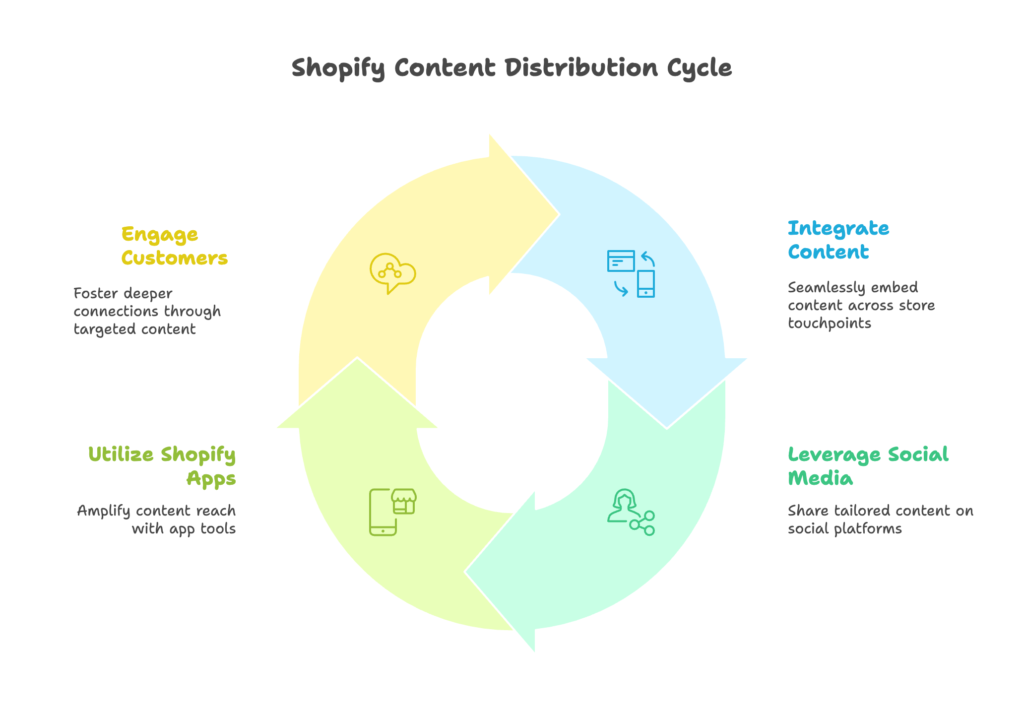
Shopify offers unique opportunities to showcase and promote your content throughout the customer journey.
Integrating Content Across Shopify Store Touchpoints
Your homepage represents prime real estate for featuring timely, high-value content. Consider adding a featured blog section that highlights your most recent or most relevant posts. This introduces new visitors to your content while giving returning customers fresh reasons to engage.
Product pages can benefit tremendously from contextual content integration. Instead of limiting these pages to basic descriptions, incorporate related buying guides, usage tips, or customer stories that address specific questions at the point of decision. Shopify’s sections feature makes this relatively simple to implement.
Don’t overlook transactional touchpoints. Order confirmation emails, shipping notifications, and post-purchase follow-ups all represent opportunities to share relevant content. A customer who purchases a yoga mat might appreciate a “5 Morning Yoga Routines” article in their order confirmation, adding value while subtly promoting complementary products.
Shopify Email provides a straightforward way to repurpose your content for email marketing campaigns. Create regular newsletters featuring your latest blog posts, buying guides, or product highlights. Segment your audience to ensure recipients receive content relevant to their interests and purchase history.
“The most successful Shopify stores think of content distribution as an ecosystem, not a series of isolated channels,” notes Alex Turnbull, founder of Groove. “Each touchpoint should connect naturally to others, creating a cohesive experience that guides customers through their journey.”
Leveraging Shopify’s Social Media Integrations
Social media remains a powerful channel for content distribution, and Shopify makes cross-platform sharing easier through various integrations. Start by connecting your store to relevant social accounts via Shopify’s social sales channels feature, which streamlines content sharing and enables direct social selling.
Each social platform has unique content requirements and audience expectations. Adapt your content accordingly rather than posting identical messages across all channels. Visual platforms like Instagram and Pinterest favor product-focused imagery and lifestyle content, while Twitter might be better for quick tips and customer service.
Shopify’s social selling features allow you to tag products directly in your social content, reducing friction between discovery and purchase. This is particularly effective when your content naturally showcases products in context, such as how-to guides, styling ideas, or creative uses for your products.
Consider creating platform-specific content series that align with your overall content pillars but are optimized for each channel’s format. For example, a cooking supply store might share quick recipe videos on Instagram, longer cooking tutorials on YouTube, and meal planning tips on Facebook – all supporting their central content themes while respecting platform differences.
Utilizing Shopify Apps for Content Amplification
The Shopify App Store offers numerous tools to extend your content’s reach and effectiveness. Content marketing apps like Blog Studio provide enhanced blogging capabilities, including better categorization, related post suggestions, and improved SEO tools that Shopify’s native blog lacks.
User-generated content represents a powerful form of social proof that can significantly impact conversion rates. Apps like Stamped.io, Yotpo, or Okendo help you collect and display customer reviews, photos, and videos throughout your store. This authentic content often proves more persuasive than brand-created materials alone.
Email marketing apps expand on Shopify Email’s capabilities, offering advanced segmentation, automation, and analytics. Klaviyo, for instance, allows you to create sophisticated email flows triggered by specific customer behaviors – perfect for delivering the right content at exactly the right moment in the customer journey.
When selecting apps for content amplification, prioritize those that integrate seamlessly with your existing tools and processes. The goal is to enhance your capabilities without creating disconnected silos that require duplicate work. Also consider performance impact – too many apps can slow your store and hurt the user experience.
Measuring and Optimizing Content Performance on Shopify
Creating and distributing content without measuring its impact is like driving with your eyes closed. Effective measurement allows you to double down on what works, improve what doesn’t, and continuously refine your strategy. Shopify provides robust analytics tools that, when properly leveraged, offer valuable insights into your content’s performance.
Utilizing Shopify Analytics for Content Insights
Shopify’s native analytics dashboard provides a solid foundation for tracking content performance. Start by examining traffic sources to understand which channels drive visitors to your content. Pay special attention to organic search traffic, which indicates how well your content is performing in search engines.
The behavior reports reveal how visitors interact with your content. Look at metrics like page views, time on page, and bounce rate to gauge engagement. But don’t stop at engagement metrics – the real value comes from connecting content to commerce.
Conversion tracking shows which content pieces actually lead to sales. Shopify’s attribution model helps you understand the customer journey, revealing which blog posts, guides, or landing pages contribute to purchases. This insight is invaluable for prioritizing future content investments.
Online store conversion rate, broken down by landing page, helps identify which content pieces are most effective at initiating successful customer journeys. A buying guide with a high landing page conversion rate, for example, might warrant expansion into a content series covering related topics.
Implementing Advanced Tracking with Google Analytics
While Shopify’s native analytics are useful, Google Analytics offers deeper insights, especially when configured for enhanced e-commerce tracking. This setup provides granular data on how content influences each stage of the purchasing process.
Start by creating content-specific goals in Google Analytics. These might include newsletter signups from blog posts, product views from buying guides, or adds-to-cart from comparison pages. Each goal should align with your overall content objectives and provide actionable data.
Custom events track specific user interactions with your content. For example, you might track when users watch product videos, download resources, or click internal links within blog posts. These micro-conversions help you understand engagement patterns and content effectiveness.
Enhanced e-commerce tracking is particularly valuable for content analysis. It allows you to see which products customers view, add to cart, and purchase after engaging with specific content pieces. This data directly connects your content efforts to revenue generation.
“The most valuable metric for content isn’t pageviews or even time on page – it’s influence on purchase behavior,” explains Dana Wilson, e-commerce analytics specialist. “When you can trace a sale back to a specific piece of content, you can calculate true ROI and make better investment decisions.”
A/B Testing Content Elements Within Shopify
Measurement provides insights, but testing drives improvement. A/B testing allows you to compare different content approaches and let data determine the winner. Several Shopify apps facilitate A/B testing, or you can use Google Optimize for more advanced experiments.
Product descriptions offer a prime testing opportunity. Try comparing feature-focused versus benefit-focused descriptions, different headline approaches, or varied content length. Even small improvements in product page conversion rates can significantly impact your bottom line.
Content placement and format also warrant testing. Does a video demonstration increase conversions compared to static images? Does featuring a buying guide on the homepage increase engagement? Does including customer reviews within blog posts enhance credibility? These questions can only be definitively answered through structured testing.
When conducting A/B tests, focus on one variable at a time and ensure you have sufficient traffic for statistical significance. Prioritize tests that align with your key business objectives – a small improvement in high-traffic, high-conversion pages will have more impact than larger improvements in rarely-visited content.
Continuous Improvement of Content Strategy
Content strategy isn’t a one-time exercise – it’s an ongoing process of refinement based on performance data, market changes, and evolving customer needs. Schedule regular content audits to evaluate your entire content library and identify opportunities for updates or improvements.
Refreshing existing content often yields better returns than creating new pieces from scratch. Update statistics, improve examples, enhance visuals, and expand on topics that have proven valuable to your audience. Shopify’s blogging platform allows you to easily update posts while maintaining their URLs and search rankings.
Pay attention to changing market trends and customer preferences. Search terms evolve, product categories rise and fall in popularity, and content formats gain or lose favor with audiences. Your content strategy should adapt accordingly, shifting resources to areas with the greatest potential impact.
Customer feedback provides invaluable direction for content improvement. Monitor comments on blog posts, questions asked through customer service, and social media discussions to identify information gaps or areas of confusion. These insights often reveal your next high-impact content opportunities.
Advanced Content Strategies for Shopify Success
As your content foundation strengthens, you can implement more sophisticated strategies to further differentiate your store and drive growth. These advanced approaches build on the fundamentals we’ve covered while pushing boundaries in terms of reach, personalization, and format innovation.
Developing a Multi-Channel Content Approach
While your Shopify store serves as your content hub, a truly effective strategy extends beyond your own domain. Develop a coordinated multi-channel approach that maintains consistent messaging while adapting to each platform’s strengths and audience expectations.
Create channel-specific content adaptations rather than simply reposting identical content everywhere. Your in-depth buying guide might become a visually-focused Instagram carousel, a quick Twitter thread highlighting key points, a detailed YouTube tutorial, and a Pinterest board with inspirational applications – all promoting the same core ideas but formatted optimally for each platform.
Consider expanding to owned channels beyond your Shopify store. A dedicated mobile app, podcast, or email newsletter can reach customers in different contexts and build deeper engagement. Shopify’s ecosystem includes apps and integrations that help manage these extended touchpoints without doubling your workload.
Strategic partnerships with complementary brands or influencers can extend your content reach to new audiences. Collaborative content – such as joint webinars, co-branded guides, or guest posts – leverages partner audiences while providing fresh perspectives for your own customers.
Implementing Personalization in Content Delivery
Generic content increasingly falls flat in an era of personalization. Shopify provides several ways to tailor content experiences to individual customers, significantly improving relevance and conversion rates.
Customer segmentation forms the foundation of content personalization. Shopify’s customer segments feature allows you to group shoppers based on purchase history, geography, or custom tags. Build content strategies for each major segment, addressing their specific needs and preferences.
Behavioral triggers create opportunities for highly relevant content delivery. A customer who views several products in the same category might receive a comparison guide. Someone who abandons checkout might receive troubleshooting content addressing common concerns. Apps like Klaviyo and Omnisend facilitate this behavior-based content targeting.
On-site personalization can dramatically improve content engagement. Consider implementing recommendation engines that suggest relevant articles based on browsing history, or dynamic content blocks that highlight different resources for new versus returning visitors. While advanced personalization may require additional apps, the conversion improvements often justify the investment.
“Personalization isn’t just about showing different products – it’s about delivering different information based on where each customer is in their journey,” notes Eliza Montgomery, personalization specialist. “The right content at the right moment can be the difference between abandonment and purchase.”
Exploring Emerging Content Formats for Shopify
As technology evolves, new content formats emerge that offer fresh ways to engage customers and showcase products. Stay ahead of competitors by thoughtfully incorporating these innovations into your Shopify content strategy.
Video content continues to grow in importance across all platforms. Product demonstrations, behind-the-scenes glimpses, customer testimonials, and how-to guides all perform exceptionally well in video format. Shopify makes it easy to embed videos on product pages, in blog posts, and throughout your store. Start simple with smartphone-recorded content before investing in more elaborate production.
Augmented reality represents a particularly valuable innovation for certain product categories. Shopify’s AR capabilities allow customers to visualize products in their own space before purchasing – especially valuable for furniture, home décor, eyewear, and similar items. Supporting AR with clear instructional content helps customers make the most of this technology.
Interactive content increases engagement by inviting active participation rather than passive consumption. Product selectors help customers find the right items based on their needs, quizzes create personalized recommendations, and calculators solve specific customer problems. These tools not only provide value but also collect valuable preference data for further personalization.
Consider the emerging potential of voice search optimization. As more customers use voice assistants for shopping research, structuring some content to answer common spoken queries can capture this growing traffic segment. FAQ sections work particularly well for voice search visibility.
Building a Community Around Your Shopify Store
Perhaps the most powerful advanced strategy is transforming customers from one-time buyers into community members who feel connected to your brand and each other. This transition dramatically increases customer lifetime value while creating a sustainable competitive advantage.
User-generated content serves as both community-building tool and powerful social proof. Encourage customers to share photos, videos, reviews, and stories featuring your products. Showcase this content throughout your store, particularly on product pages where it can influence purchase decisions. Apps like Foursixty and Pixlee simplify collection and display of this valuable content.
Consider creating exclusive content available only to customers or community members. This might include advanced tutorials, early access to new content, member-only webinars, or specialized guides. This approach rewards loyalty while providing incentives for new customers to join your community after purchase.
Facilitate direct connections between customers through moderated forums, Facebook groups, or in-person/virtual events. These spaces allow customers to share experiences, ask questions, and develop relationships centered around shared interests related to your products. Your role becomes that of community facilitator rather than just content creator.
Recognize and celebrate community contributions to reinforce participation. Highlight customer projects, feature community members in your content, and acknowledge valuable insights shared by your audience. This recognition strengthens community bonds while providing authentic content for your broader marketing efforts.
References
- Shopify. (2025). “Content Strategy Guide for E-commerce.” Shopify Blog. https://www.shopify.com/blog/content-strategy-guide
- Johnson, A. (2024). “The Impact of Content Marketing on E-commerce Conversion Rates.” Journal of Digital Commerce, 15(2), 78-95.
- E-commerce Content Marketing Institute. (2025). “Annual Benchmarks, Budgets, and Trends—E-commerce Content Marketing.” https://www.ecommerce-content-marketing-institute.com/research/2025-benchmarks
- Smith, B. (2024). “Optimizing Content for Shopify’s Ecosystem.” Shopify Partners Blog. https://www.shopify.com/partners/blog/optimizing-content
- Anderson, L. (2025). “Advanced SEO Techniques for Shopify Stores.” Search Engine Journal. https://www.searchenginejournal.com/shopify-seo-techniques/
- Shopify Plus. (2025). “Enterprise E-commerce Content Strategy Playbook.” Shopify Plus Resources. https://www.shopify.com/plus/resources/content-strategy-playbook
Ready to supercharge your Shopify store’s sales with perfectly optimized discount codes and personalized campaigns? Growth Suite is a Shopify app that helps you analyze customer behavior, run effective discount campaigns, and boost your conversion rates. Its AI-driven engine creates personalized offers for each visitor at the perfect moment. Install it with a single click and start transforming browsers into buyers!
Don’t forget to check other articles;
Content Marketing & SEO for Shopify
Creating a Content Calendar for Your Shopify Store: From Planning to Execution
Competitive Content Analysis: How to Outperform Other Shopify Stores
Content Mapping for Shopify: Aligning Content with Customer Journey Stages
Repurposing Content Across Channels: Maximizing Your Shopify Content ROI
